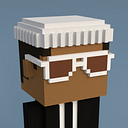Deciphering 27-Bit Digital
My project, 27-Bit Digital, launches on Art Blocks, Friday, 19 Feb 2021 @ 9am PST / 5pm GMT

Introduction
I’ve written about my influences, and had an interview with Jeff Davis about it, so this is a quick guide to what you can find in the randomly generated pieces.
People who know me from the crypto-collectibles / NFT space may be familiar with the rabbit-hole I went down in 2017 when I deciphered the CryptoKitties Genome — so it’s only fitting that I crack the code of my own project, and explain how I’m using 27-bits of random data to create the art pieces.
Patterns
I’ve mentioned in previous posts that I’ve been fascinated since childhood with these simple patterns that create such a variety of colors and textures. For a piece of generative art, I love that this is a completely random distribution across 12 bits. 3 bits for switching on Red, Green and/or Blue, repeated in a 2x2 pixel pattern.

I’ve given these emergent patterns the following names:
- Whiteout — White background, glyph is white on white
- Blackout — Black background without a glyph (ghost)
- Binary — Black background with a glyph
- Black & White — Only white pixels used in the pattern
- Solid — All 4 pixels are the same color
- Bars — Colors repeat as vertical bars
- Stripes — Colors repeat as horizontal stripes
- Scanlines — Single horizontal line of a color alternating with black
- Checkerboard — 2 colors alternating
- Pointillist — 1 of 3 pixels is a different color
- Highlighter — I liked how this pattern looked like a yellow highlighter going over a blue highlighter with additive colors, in 4 variants that look like this
- Mix — All remaining color combinations
Glyphs
A uniform random distribution of 7 bits assigned to a 7-segment display.
I’ve given names to the ones that resemble numbers and letters:
Alphabetic
Resembling letters in the alphabet: A, b, C, d, E, f, h, J, L, n, P, U, X, Y

Alphanumeric
Can work equally as a letter or a number: 1 or l, 0 or O, 5 or S

Numeric
Resembling numbers: 2,3,4,6,7,8,9,11

OTTO
This is a little bit autobiographical. As a kid, I used to write sci-fi stories, and when I chose the name of a robot or an AI character, I would use ‘OTTO’ because of how it resembles a binary number, 0110.
So I thought it would be fitting for a robotic face glyph.

Resolution
This is the only part of the project which does not use uniform random distribution, but instead selects from the next 8 bits to choose the density of the pattern.

- LoRes — Each ‘pixel’ is 32x32 in size, making it ‘chunkier’
- VGA — 16x16 size
- HiRes — 8x8 size
Patterns (12 bits) + Glyphs (7 bits) + Resolution (8 bits) = 27-Bit Digital
Second in a series about my upcoming blockchain collectible Art Blocks project, 27-Bit Digital.
My project launches Friday, 19 Feb 2021 @ 9am PST / 5pm GMT
Further reading about 27-Bit Digital
- When Retro Graphics Weren’t Retro — My influences for the project
- In Conversation: Kai Turner by Jeff Davis
